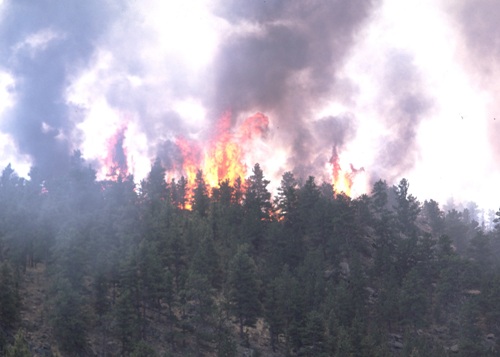Oregon State University Forestry & Natural Resources Extension started a blog in 2015 on Oregon Forests and Climate Change. The goal of the blog is to assist Oregon’s private forest owners in understanding basic climate science principles, anticipated impacts on managed forests, and options for adaptation and management. Several articles have posted to this blog already, and we provide specific links to them here. As OSU Forestry and Natural Resources Extension updates the blog, we will add the new …
Webinars on Demand!
If you missed a climate and natural resources webinar of interest, check out the links below.
ANREP Climate Science Initiative Webinars:
“Extension Leadership with Community Climate Planning Scenarios”
“Benefiting Clientele and Educators through Climate Education Networking”
“Extension Climate Communication in Practice”
“Urban, Rural, and Remote: Extension Climate Adaptation Programs and Practices”
“FloriDays Cutting-Edge Extension”
“The North Coast Alignment Project” and “Delaware’s Climate Change Impact Assessment”
The Role of Universities in Climate Change Education and Research
ClimateWebinars.net:
Preventing Forest Tree Illness

Do not wait to act on insect and disease issues until after you see dead branches. Look for visible symptoms or signs of tree illness and learn how to prevent a favorable environment for organisms that harm trees. It is important to understand that successful methods for minimizing forest insect and disease problems are usually preventative, occurring before problems are noticed. Monitoring your forest for …
Regional Climate Hub Assessment of Climate Change Vulnerability and Adaptation and Mitigation Strategies

USDA’s Regional Climate Hubs were established in February of 2014 to deliver science-based knowledge, practical information, and program support to farmers, ranchers, forest landowners, and resource managers to enable climate-informed decision-making in light of the increased risks and vulnerabilities associated with a changing climate. As part of their function, the Hubs were tasked with providing periodic regional assessments of risk and vulnerability to production sectors and rural economies, building on material provided under the National Climate Assessment conducted through the …
Overview of Effects of Climatic Variability and Change on Forest Ecosystems in Alaska
The Global Change Research Act of 1990 requires the U.S. Global Change Research Program (USGCRP) to produce the National Climate Assessment (NCA) for the President and Congress every four years, analyzing the effect of global change on multiple sectors and regions in the United States and projecting major trends forward for up to 100 years. Effects on Climatic Variability and Change on Forest Ecosystems: A Comprehensive Science Synthesis for the U.S. Forest Sector (PNW-GTR-870) serves as the U.S. Forest Service …
Overview of the Effects of Climatic Variability and Change on Forest Ecosystems of Northwest United States
The Global Change Research Act of 1990 requires the U.S. Global Change Research Program (USGCRP) to produce the National Climate Assessment (NCA) for the President and Congress every four years, analyzing the effect of global change on multiple sectors and regions in the United States and projecting major trends forward for up to 100 years. Effects on Climatic Variability and Change on Forest Ecosystems: A Comprehensive Science Synthesis for the U.S. Forest Sector (PNW-GTR-870) serves as the U.S. Forest Service …
Alaska Climate Assessment
Adapted by Melanie Lenart, University of Arizona, Reviewed by Susan E. Moore and Mark A. Megalos, North Carolina State University, from: Chapin, F. S., III, S. F. Trainor, P. Cochran, H. Huntington, C. Markon, M. McCammon, A. D. McGuire, and M. Serreze, 2014: Ch. 22: Alaska. Climate Change Impacts in the United States: The Third National Climate Assessment, J. M. Melillo, Terese (T.C.) Richmond, and G. W. Yohe, Eds., U.S. Global Change Research Program, 514-536. Accessible online at: http://nca2014.globalchange.gov/report/regions/alaska.…
Climate Change Impacts on Forest Diseases
Written by Tom DeGomez, University of Arizona
Forest disease organisms and abiotic occurrences that lead to diseased trees are common in terrestrial ecosystems. Most of the disease organisms within forests are essential to the health of the system and are present at background levels, generally occurring on weakened members within a forest stand. Occasionally, diseases can overcome a forest system and a stand-replacing event will occur, but this is a rare event even in the least resilient forests. The full …
Climate Change Impacts on Forest Insects
Excerpt from: Régnière, J. 2009. Predicting insect continental distributions from species physiology. Unasylva. 60:37-42.
Insects constitute the most diverse form of animal life in terrestrial ecosystems. Most species are innocuous but essential components of natural ecosystems. Because they are cold-blooded, the rates of key physiological processes in their life cycles are determined by environmental conditions, especially temperature and precipitation. In general they have short generation times, high fecundity, and high mobility (either through their own faculties or aided by wind, …
Wildfire and Climate
Adapted from: Rogstad, Alix; Crimmins, Michael; and Garfin, Gregg. 2006. Climate change and wildfire impacts in Southwest forests and woodlands. University of Arizona College of Agriculture and Life Sciences. Publication No. az1425
Wildfire requires three things to burn: an ignition source, fuel, and oxygen. If one of the three requirements is removed, the fire activity will be …

